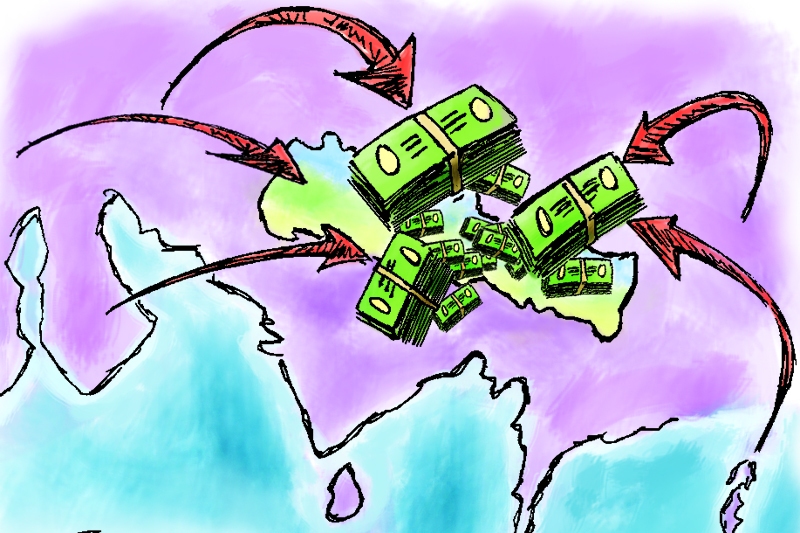Remittance inflows: Avoiding dependence
Remittances form a vital pillar of Nepal’s economy and have been a valuable buffer during volatile periods; however, long-term dependence on them should be avoided
Remittances have captured the attention of researchers and policymakers by spurring debate on their pros and cons.
On the one hand, many studies have evinced that these financial flows can greatly improve the livelihoods of receiving households by promoting education, health and capital investments.
At an aggregate level, positive effects include economic stability, improved creditworthiness, financing of current account deficit and greater access to foreign capital that can boost economic growth.
Directing remittances through the formal financial system can pave the way for financial inclusion and generate investment opportunities. On the other hand, a few studies have also illustrated how remittances have adversely affected the receiving economy by cultivating a culture of dependency that lowers labor supply and promotes conspicuous consumption.
At a macro-economic level, it has been shown that remittances have a negative effect on exchange rates and the export sector through the Dutch disease. The empirical evidence, thus, remains mixed.
Still, it is generally acknowledged that remittances are very crucial to both the national economy of developing countries and the individual households as a mechanism to escape poverty.
Besides households, the government also derives benefits as remittances utilized on the consumption of both domestically produced goods and imports raise the tax base, which subsequently increases revenues from sales taxes, value-added taxes, and import duties.
Nevertheless, it would be unwise for any developing country to place remittances at the heart of their development strategy. Attaining long-term sustainable development demands a multidimensional approach in which outward migration is just one constituent element.
Remittances are the bedrock of Nepal’s economy, forming about 30 percent of GDP and have been providing households with additional money to spend on daily needs, education, health and property.
Since the upsurge in the inflow of remittances is the upshot of the increase in the outflow of primarily semi-skilled and unskilled workers who come from poor households, the money send back has positive impact on the living standards of the families left behind.
Remittances have also been responsible for maintaining the balance of payments in surplus for most of the last decade despite unstable political and economic conditions.
Hence, remittances are indispensable for Nepal at its current stage of development as these flows have provided a much required safety value for the economy, enhanced disposable incomes and reduced the incidence of poverty.
But there are also costs associated with remittances. Since the health and welfare of those who work overseas often suffer, while the funds they send home are rarely utilized productively, it is high time for policy makers to develop a clear vision and formulate effective and implementable strategies on foreign employment and remittances.
Better regulations and governance of labor migration would help to improve the safety and welfare of migrant workers.
Moreover, effective supervision of recruitment agencies could prohibit exploitation of migrant workers. In order to implement effective and efficient public policies to direct remittances into productive
programs, the government has to investigate into what inspires Nepalese to send money home especially beyond individual family remittances, and design its policies to take advantage of it.
To cite an example, Nepal could follow the path of some Latin American countries where hometown associations (HTAs) which are organizations formed by immigrants from the same village, town, community, or institution are engaged in a variety of development projects.
Through remittances, these organizations seek to support, and to maintain connections with, their members’ places of origin.
However, in recent months, the remittances data has not been portraying a satisfactory picture. Remittance inflows to Nepal rose by just 5.7 percent to Rs. 342.2 billion in the first half of 2016/17, compared to its growth of 17.3 percent in the same period of the previous year.
Likewise, the outflow of migrant workers plummeted to a three-year low in the first half of 2016/17, declining by about 10 percent, compared to the first half of 2015/16.
This drop has been primarily attributed to the paucity of employment opportunities in the destination countries, especially the Gulf Cooperation Council (GCC) countries, arising from the weak price of oil and policies favoring employment of nationals over migrant workers.
The deceleration in remittance inflows could wield pressure on the external sector, especially foreign exchange reserves and balance of payments, as imports have continued to soar.
This deceleration also seems to appear as one of the responsible factors for the shortage of loanable funds in the banking system in recent months. Overall, this situation has been unfolded because of Nepal’s overdependence on remittances.
To conclude, remittances form a vital pillar of Nepal’s economy and have been a valuable buffer during volatile periods; however, long-term dependence on them should be avoided.
There is not a single country that has ever succeeded in sustaining growth and job creation on remittances alone.
Pant works at Nepal Rastra Bank






